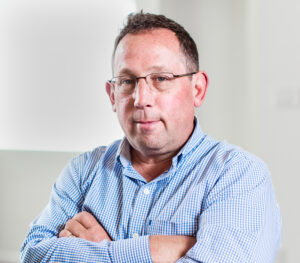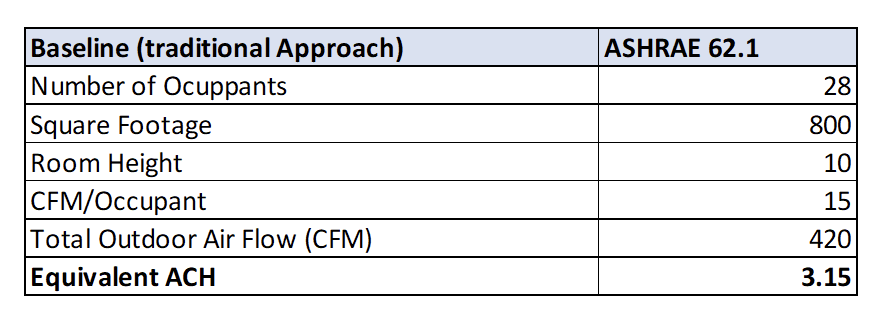Jeremy McDonald speaks on leveraging ASHRAE 241 to improve IAQ without “breaking the bank”
Over the past six months, end users, such as myself, have been evaluating ASHRAE 241 (Control of Infectious Aerosols) to determine how the Standard will affect our clients. As a consulting engineer in service to the health care, higher education and multi-family market, I am not only concerned with the improved IAQ, which will be realised through ASHRAE 241, but also with ensuring that energy budgets don’t increase dramatically.
ASHRAE prescribes a “minimum equivalent Clean Airflow per person” for several standard spaces. These new prescribed minimum airflow rates are much higher than previous airflow rates, as dictated by ASHRAE 62.11, which designers historically used to determine required outdoor air airflow rates. For example, ASHRAE 62.1 typically requires approximately 15 cfm/occupant, while ASHRAE 241 will require 40 cfm/person of “equivalent clean airflow”.
 Before we panic too much regarding the new targets, it is important to understand the nuance – that the new prescribed levels are “equivalent clean airflow rate”, while ASHRAE 62.1 only provided absolute outdoor airflow rates. Further, the intent of the new targets is only to elevate the level of equivalent clean airflow when the facility is deemed to be in “Infection Risk Management Mode”, or IRMM. The IRMM mode will be documented in the “Building Readiness Plan” and will typically be reserved for times of high risk – that is, when the building owner, Authority Having Jurisdiction (AHJ-local code official) or public health officials deem the local conditions to warrant special care with regard to infectious aerosols.
Before we panic too much regarding the new targets, it is important to understand the nuance – that the new prescribed levels are “equivalent clean airflow rate”, while ASHRAE 62.1 only provided absolute outdoor airflow rates. Further, the intent of the new targets is only to elevate the level of equivalent clean airflow when the facility is deemed to be in “Infection Risk Management Mode”, or IRMM. The IRMM mode will be documented in the “Building Readiness Plan” and will typically be reserved for times of high risk – that is, when the building owner, Authority Having Jurisdiction (AHJ-local code official) or public health officials deem the local conditions to warrant special care with regard to infectious aerosols.
ASHRAE allows the effectiveness of filtration and air-cleaning devices to help meet the target. This new way of thinking takes into account that not every filtration system is the same, but specific air-cleaning technologies that are installed and maintained correctly can have a meaningful effect on purifying the air we all breathe.
Let’s keep it simple – meeting ASHRAE 241
The new ASHRAE 241 Standard provides several tools to meet the new minimal equivalent airflow per person rate, and is not too arduous compared to current standard practices. As
stated earlier, filtration, which is pretty standard for most air-handling units, and air cleaning technologies, which are becoming more prevalent, are two strategies that building owners can use to ensure their building is ready for high-risk time period (“IRMM” period).
The following tables demonstrate the air exchange improvements that can be realised by filtration and typical air-cleaning technologies.
The first table is the “baseline”, which demonstrates typical air exchange of outdoor air for natural ventilation, as dictated by ASHRAE 62.1.
 The following table demonstrates equivalent clean air exchange rates for three options: MERV-14 filtration, air cleaning technology @ 95% (could be air ionisation, ultraviolet or any other air cleaning technology) and a combination of both.
The following table demonstrates equivalent clean air exchange rates for three options: MERV-14 filtration, air cleaning technology @ 95% (could be air ionisation, ultraviolet or any other air cleaning technology) and a combination of both.

A few observations can be made from the above analysis:
Ø Application of either MERV-14 filters or air-cleaning technology at a nominal rate of 95%, which is quite conservative, will meet the target of 40 cfm/occupant.
Ø Combining the two technologies only gives a marginal increase to the cfm/occupant. This is as expected, since the two independent technologies are serving the same purpose – that is, reducing infectious aerosols; therefore, effectiveness is reduced, as more layers of protection are added to the system.
Ø The equivalent air changes per hour (ACH) of clean air is increased dramatically from 3.15 ACH for the baseline (ventilation only) to the various options (equivalent ACH ranges between 8.4 and 9.1 for the combined case).
This analysis demonstrates that significant improvements in clean air ACH can be realised by some pretty simple and cost-effective additions. At a minimum, MERV-14 filters are not an expensive addition to most HVAC systems and are increasingly commonplace. Of course, testing and adjustments need to be done to ensure the design airflow is attained with the higher pressure drop filter, but this will not be an issue for the vast majority of systems.
Although air cleaning may be seen as redundant to a filtration system, we normally recommend that air-cleaning technologies be added with improved air filtration systems as part of an IAQ upgrade. Although this might be viewed as “belts and suspenders”, systems do fail, including filters. Having a separate air-cleaning system is good insurance that we meet occupant IAQ needs, even when things go wrong, as they often do.
Getting to work on improved IAQ
ASHRAE 241 provides a pragmatic path to improved IAQ. Vastly improved IAQ can be attained with either better filtration, air-cleaning technologies, or both.
Note that we are not talking about very expensive systems. MERV-14 filters are pretty standard in a post-pandemic world, and air-cleaning technologies, assuming basic HVAC systems are working, will not break the bank (typically costing anywhere between USD1 and USD3/square foot installed cost).
Think through maintenance and utilisation of whatever approach you choose. While making these investment decisions, be sure that in whatever approach you choose, the systems are well maintained, checked on a regular basis and are delivering the clean air that you want your clients to benefit from.
1 “ASHRAE 62.1-Ventilation and Acceptable Indoor Air Quality”, is a Standard which is published, maintained and updated by ASHRAE. The Standard, which is accepted by most jurisdictions as law, establishes the minimum outdoor air requirements for occupied buildings and spaces of all types.
Jeremy McDonald is a principal of Guth DeConzo Consulting Engineers, in New York. Before the pandemic, he was an adjunct professor at Rensselaer Polytechnic Institute. Recently, he was the technical consultant to the New York State Energy Research and Development Authority in development of an IAQ guideline for Higher Education in NY: “Covid-19 Response Guide, State University of New York”. He may be reached at jmcdonald@guthdeconzo.com.
Copyright © 2006-2025 - CPI Industry. All rights reserved.